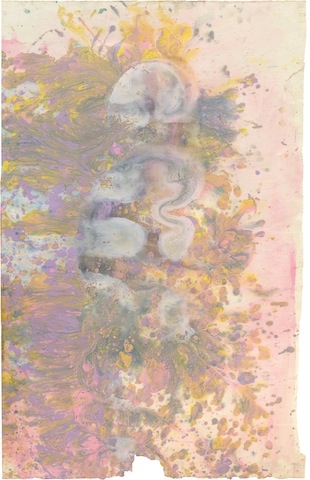Hales Project Room, New York, 6 September – 15 October
In the art criticism he wrote during the early 1970s, Frank Bowling chafed against the then-pervasive ‘black art’ label, which he found limiting rather than liberating. In an artist statement from 1972, he formulates the act of making abstract-expressionist paintings as political: ‘The practice of painting within the boundaries of Formalism provides a setting in which I am able to test and ultimately prove my own freedom.’ Bowling’s take on abstract painting feels as urgent as ever in Metropolitanblooms, a diminutive show of six works Bowling made between 1978 and 1986.
Timed to a coincide with a Bowling show at the gallery’s London headquarters, this exhibition is also concurrent with Bowling’s major retrospective at the Haus der Kunst in Munich as well as his inclusion in Tate Modern’s Soul of a Nation exhibition. Among these more notable offerings, this tiny show stands out because New York has unfortunately seen far less of Bowling than Europe has. I won’t use the stale label ‘overlooked’ to describe Bowling – he certainly hasn’t been – but he regrettably hasn’t had a solo institutional exhibition in New York since his Whitney Museum show in 1971.
the painting’s surface becomes a tactile object rather than a sacred space
The works on view are heirs to an ab-ex sensibility, but complicate a limited view of modernist painting. Made when Bowling had just relocated from New York to London (and to a much snugger studio), these smaller and more intimate paintings shrug off the bravado of the New York School’s monumental abstraction. Rather than the great whooshes of colour found in the poured paintings that precede them, the works from this period allow pours to puddle, and Bowling has built up their palettes in layer upon layer of swampy drips and swirls of paint.
It’s interesting to see the formal interests Bowling shares with his peers – Sam Gilliam’s paintings on rice paper from the 1970s come to mind, as do Al Loving’s paper collages from the same period. Bowling has also taken on Helen Frankenthaler’s colour sense and Lynda Benglis’s drippy tactility. The show’s two works on paper, Autumn Flare (1986) and Vase (1985), are undeniably its standout pieces. In Autumn Flare, the paper’s absorption of thickly applied layers of yellow, pink and purple paint creates an alluring ripple that emphasises the colour’s physicality and its glopping sensuality. Vase is all pastel pinks and purples, but rips and tears along its edges make the work feel refreshingly unprecious – the painting’s surface becomes a tactile object rather than a sacred space. Though small in size, this show proves Bowling to be a crucial figure in expanding our understanding of the political potential of abstract and expressionistic painting.
From the December 2017 issue of ArtReview
